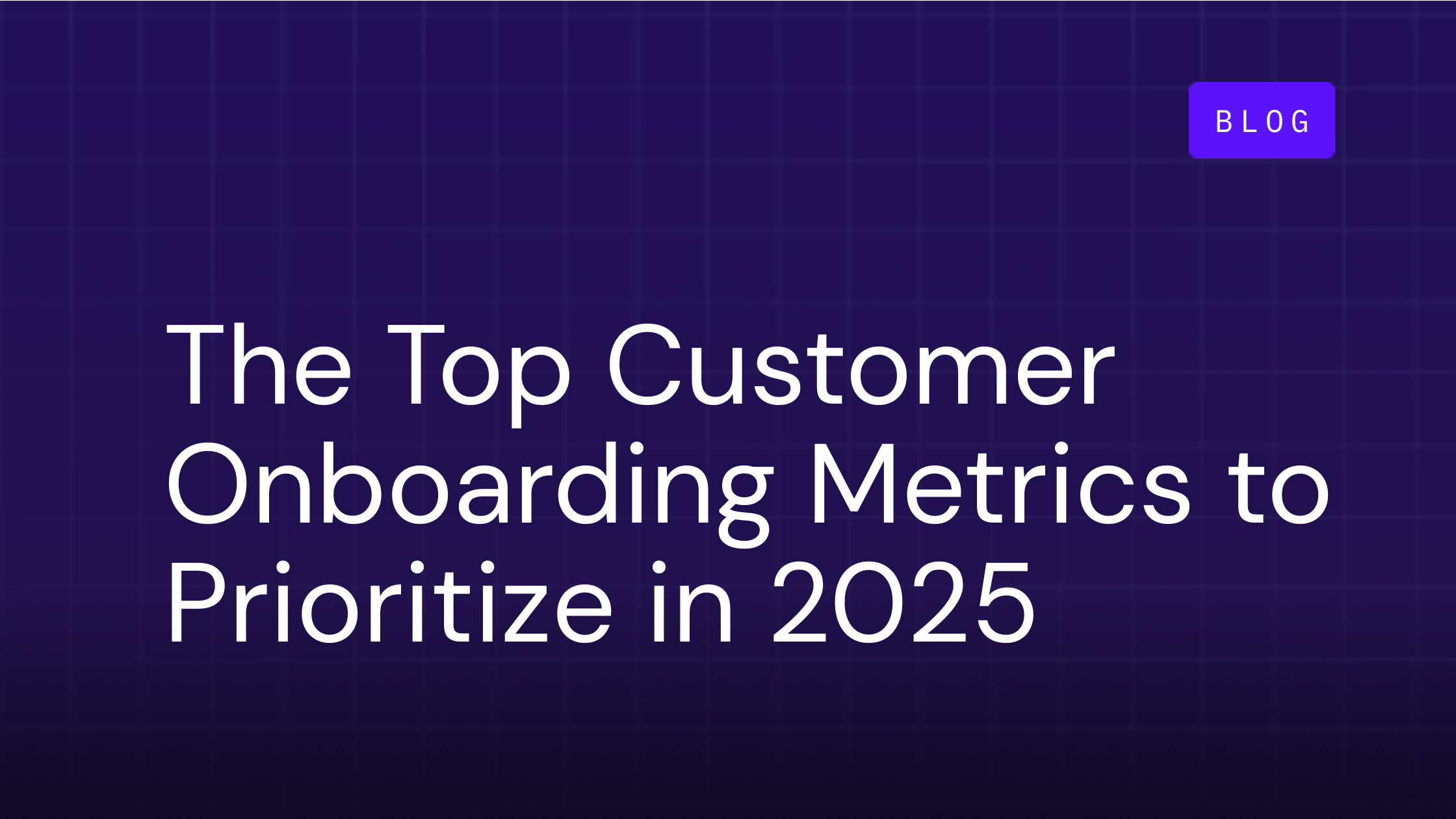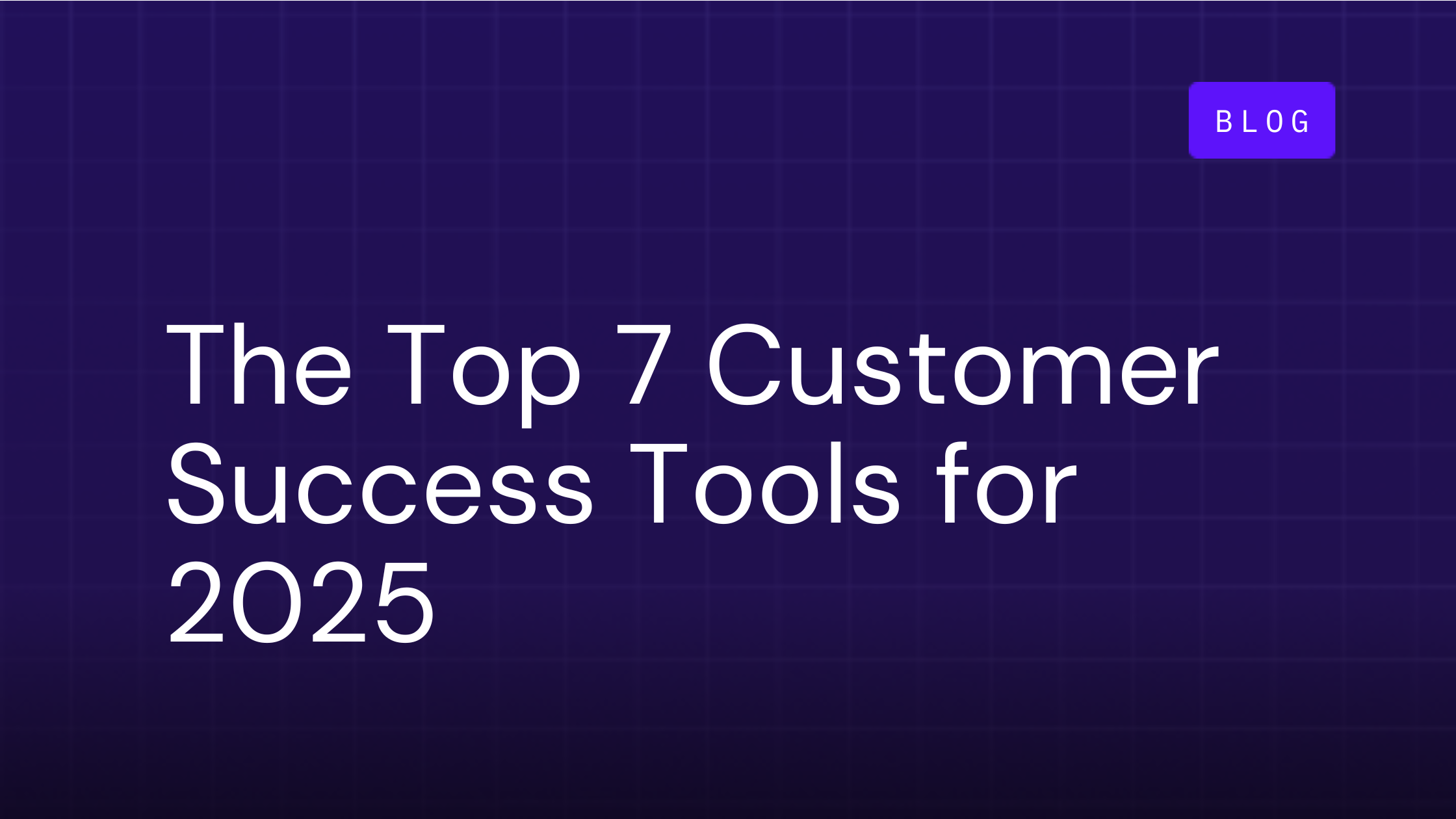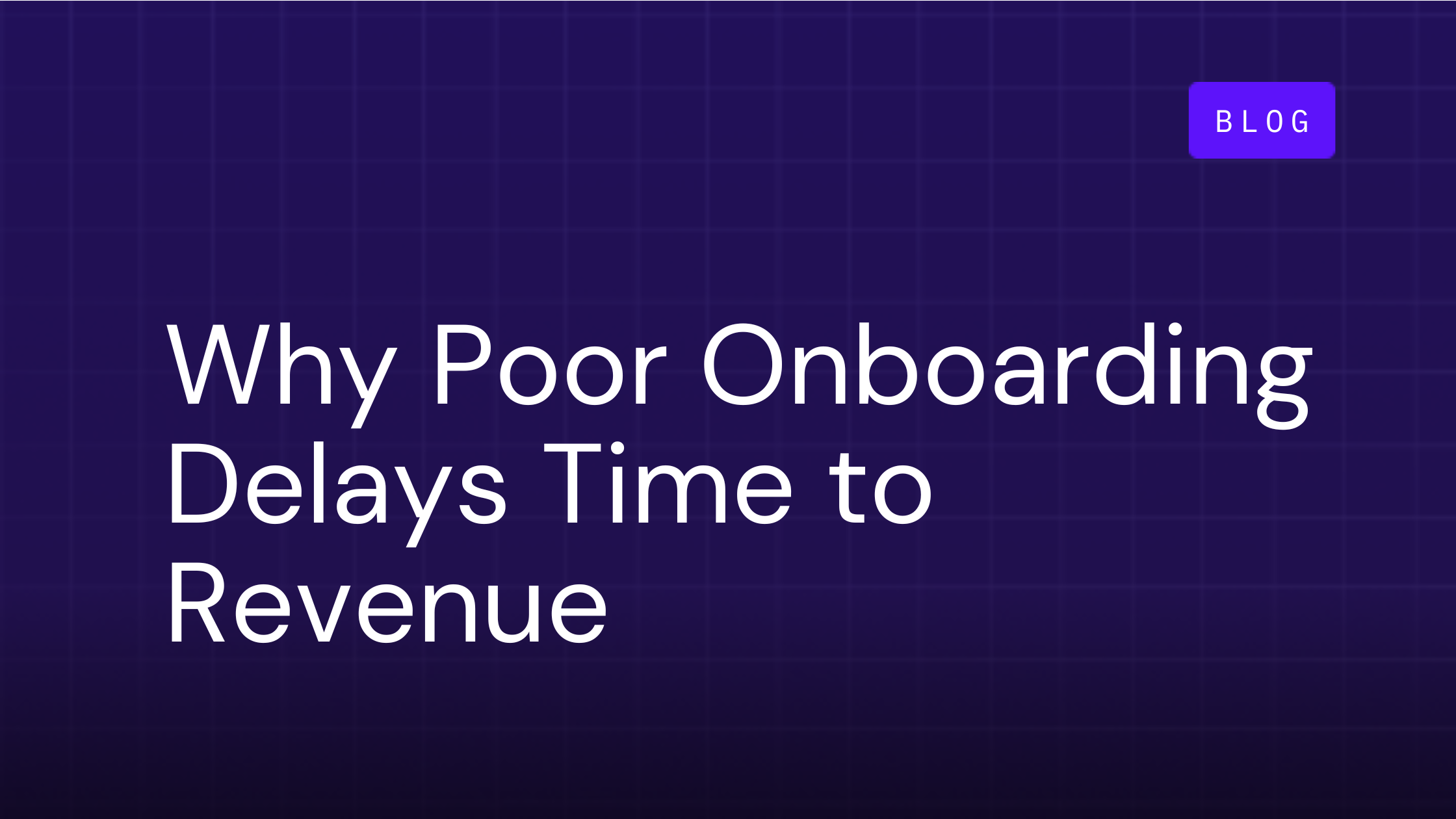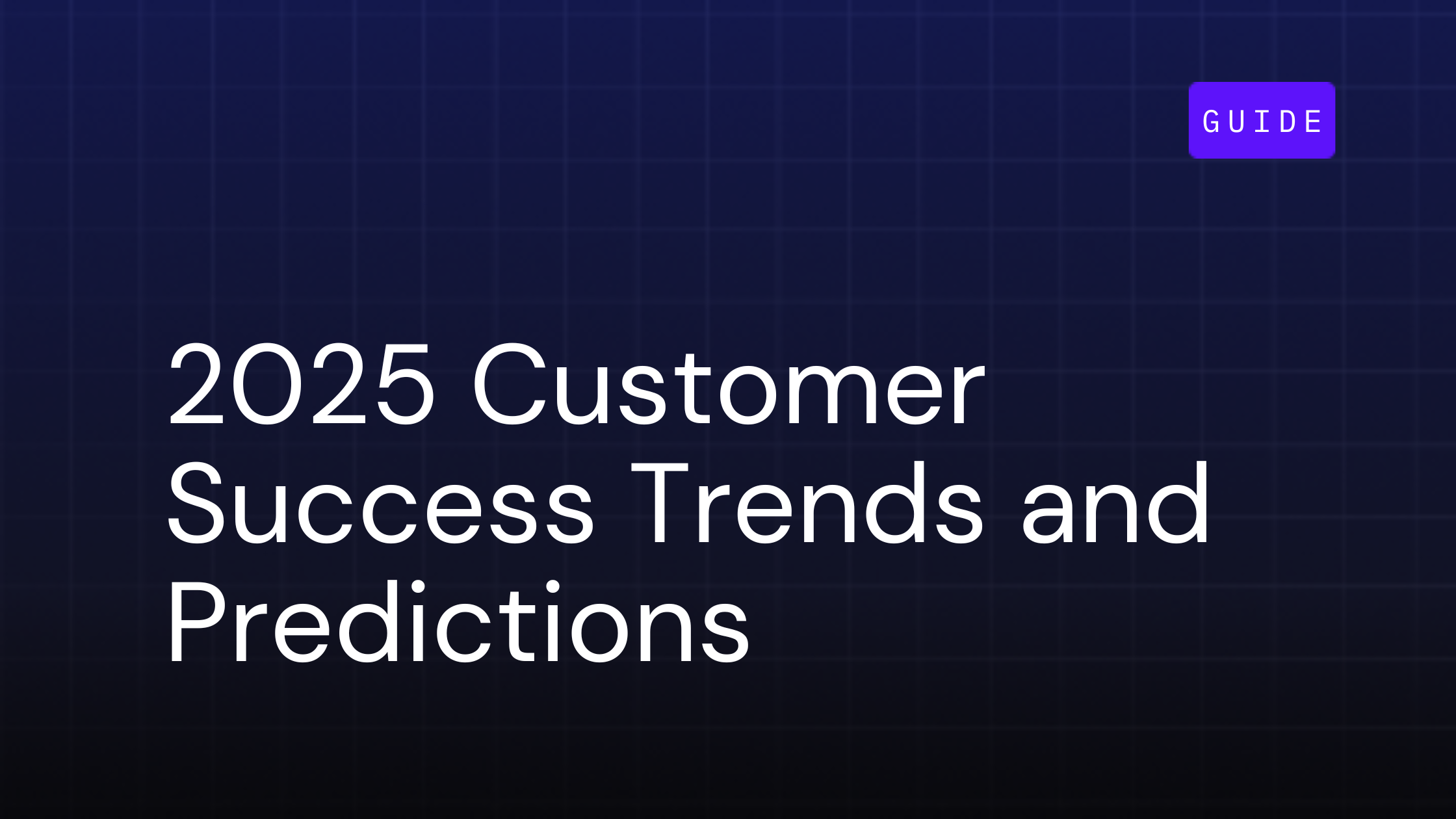The Top Customer Onboarding Metrics to Prioritize in 2025

Table of Contents
Offering exceptional customer onboarding gives your company a competitive advantage that yields results in the long-term. It's crucial for driving user activation, engagement, retention, and growth. However, many customer success teams still take an ad hoc approach without measuring performance, leaving opportunities for improvement on the table.
After all, what gets measured gets managed, and accurately tracking your customer onboarding metrics gives you visibility, helps you set targets, and enables your team to make data-driven decisions about your onboarding processes.
In this article, we’ll explore how to measure onboarding success. Rather than relying on gut feelings, incorporate these onboarding metrics into your KPI dashboards this year to elevate your strategy and outcomes.
Why are customer onboarding metrics important?
Tracking SaaS onboarding metrics can help your team continuously improve, delivering results to your business in the form of increased efficiency, better collaboration, improved customer satisfaction, longer customer lifetime values, and a better bottom line. Not only does tracking onboarding metrics help you improve the customer experience, it can also help businesses figure out ways to operate more efficiently.
Here’s a glance at how onboarding metrics and onboarding KPIs can help your business:
- Bolster the customer experience to improve customer relationships, thereby encouraging customers to stick around longer – and spend more on additional features.
- Provide insights into customer behaviors and preferences.
- Unveil inefficiencies in your team’s process.
- Inform decision making with data-driven insights.
- Identify patterns, trends, and challenges before they occur.
In the end, tracking customer onboarding metrics can help you drive conversions, reduce customer churn, and boost overall customer engagement. But tracking these metrics doesn’t just happen overnight – your team will need to create systems and methods to maintain accurate data and establish practices of analyzing that data on a regular basis to adjust your strategy accordingly. So, let’s dive into the most important customer onboarding metrics you should track in 2025 to get your business to the next level.
What are the essential customer onboarding metrics to track?
Time-to-Value Metrics
Tracking how long your customers take to get concrete value from your product is crucial — after all, quick wins are priceless. To get a sense of this, you should track the following key customer onboarding metrics.
Onboarding Completion Time or Time to Onboard
Simply put, this measures how long it takes before new users officially finish onboarding and graduate to be full-fledged customers. The trick here is to keep this time as short and efficient as possible. Your onboarding process should focus entirely on how to use the product in applicable terms, incorporating key insights that fit into their workflow so they can soon go off and use it independently. The key? Get up and running as fast as possible – wasting as little of their time, and yours, as possible – without skimping out on the educational value that customer success leaders can offer. You want your customers to feel supported, without spending excess time getting started.
- How do you measure the average Onboarding Completion Time? Sum up the duration that each customer spent onboarding and divide that by the number of customers who went through onboarding.
Time to value (TTV)
TTV tracks the time it takes from when a new customer starts the onboarding process to when they start seeing benefits from using product or service – in the world of SaaS onboarding metrics, this is the customers’ “aha moment.” Of course, the sooner your customers realize the value you add to their business, the better off you are, as this will reduce other negative metrics like customer churn. Note that the value here is in the eyes of the customer, not your company, so it’s important to always be offering your customers features and capabilities that matter most to them. One key to keeping this time as short as possible? Having a well-orchestrated onboarding process.
- How do you measure TTV? There isn’t a straightforward formula here, as this is somewhat of a subjective metric that will change on a customer-to-customer basis. Track when each customer begins onboarding and when you find out they are realizing value (or seeing ROI) from using your product/service. For customers on a free trial, you can infer this moment around when they upgrade to the paid version, or when customers start adopting new features. Part of measuring TTV requires your customer success team to be tapped-into their accounts, and regularly reaching out to see how adoption is going.
Activation Metrics
Activation metrics quantify whether your product makes a killer good first impression. Track the following metrics to see how customers are receiving your product or service.
Account Activation Rate
This metric tracks the percentage of new signups that activate their account. Low rates indicate onboarding friction and can indicate areas where your team needs to make essential improvements.
- How do you measure Account Activation Rate? Use this formula: (Number of activated users/Number of total new users) x100
Feature Adoption Rate and Product Adoption Rate
These metrics analyze the percentage of your customer base that use certain features of your products in a time period, helping your company determine how popular various features are. This can help you identify areas of focus for the onboarding process, as well as indicating feedback for the product team. First, you will need to determine what level of usage indicates adoption (is it once per day, week, etc.) A higher adoption means your onboarding drives engagement with key product capabilities.
- How do you measure Adoption Rates? Divide the total number of users who have adopted a particular feature or product by your total number of customers.
Onboarding Task Completion and Completion Rate
Use these metrics to track the percentage of assigned onboarding tasks and activities users fully finish. As it sounds, the Completion Rate measures how many new customers entered an onboarding program and finished it. Higher completion rates signal an effective onboarding structure, which is a win for your team. Low rates can also show you where customers might not be following along with the process, or understanding features of the product or service, indicating that your team may need to modify some processes.
- How do you measure Onboarding Completion Rate? Divide the total number of customers who completed a task or process by the total number of onboarded customers in that time period.
Free-to-paid Conversion Rate
This shows how many users transitioned from a free trial to a paid version of your product or service – an important SaaS onboarding metric. Users who are satisfied with the free trial will often upgrade to a paid version once that trail ends, which is a good sign for your business. But at that point, onboarding becomes even more important to retain those customers.
- How do you measure Free-to-Paid Conversion Rate? Use this formula: (Total number of customers who convert from free to paid / total number of free trial users during the same time frame) x 100
User Engagement Metrics
Engagement metrics reflect overall usage and interactions within your product which is an essential indicator of a customers’ behavior and satisfaction in the early days of customer onboarding.
Frequency of Product Usage and In-App Interactions
This metric tracks how often users actively use your product daily, weekly, or monthly. Higher usage rates highlight sticky adoption resulting from quality onboarding. Lower adoption rates mean your team might have some work to do. Similarly, In-App Interactions measure the number of clicks, taps, searches, and other actions within the product. More interactions signal engagement.
- How do you measure Frequency of Product Usage and In-App Interactions? Calculate the number of times a customer interacts with your product in a given window of time.
Engagement with Onboarding Materials and Engagement Rate
Tracking engagement means assessing how many views or clicks your onboarding materials received. This can include engagement with guides, videos, messaging, and more. Lower engagement may indicate ineffective content that your team should work to improve. Your engagement rate really assesses how involved your customers are throughout the onboarding process.
- How do you track Onboarding Engagement Rates? There are many metrics you can look at to determine this value, including time spent with different onboarding materials, click through rates on various guides or quizzes, participation numbers in interactive elements, views on videos, and more.
Customer Progress
Your onboarding process should logically follow a route of progression for customers so that their learning is efficient and effective. Beyond that, you can look to see how far along customers are getting in this progression by measuring Customer Progress. By offering training in various formats, such as videos, quizzes, guides, articles, blogs, and infographics, you can help customers move through the information, so they gain an understanding of how to adopt your solutions.
- How do you track Customer Progress? This can be done by quantifying how many customers that onboarded in a particular time frame made it to each stage of the onboarding materials, or how many stages your customers passed through in the onboarding materials over a particular time period.
Customer Satisfaction Rates
Satisfaction metrics provide qualitative data on the user onboarding experience. And without customer satisfaction, a business cannot continue to thrive – so pay particular attention to these key indicators and onboarding metrics.
Net Promoter Score (NPS)
This is a standardized metric that shows the likelihood of users recommending your product. Onboarding plays a key role in driving advocacy, and determining this metric requires customer feedback in the form of a survey or poll. Companies will commonly ask questions after service, such as “How likely are you to recommend this to a friend?” That is an NPS survey.
- How do you measure NPS? Use this formula: NPS=% Promoters - % Detractors found in your survey or poll.
Number of Early-Stage Support Tickets or Ticket Volume
Tracking how many support tickets you get in a customers’ early stages can indicate how successful the onboarding process has been. It monitors the volume and sentiment of support tickets immediately after onboarding. High volumes of tickets filled with complaints signal clunky onboarding requiring refinements.
- How do you measure Early-Stage Support Tickets? Quantify the number of tickets received from customers under a certain duration.
Escalation Response Time and Average Response Time
Customers typically want instant resolution and support when they have issues, and providing fast service is key to maintaining high customers satisfaction scores. One way to measure this is to track how long it takes to resolve a complaint from the time it was submitted. Tracking these durations can give you a glimpse into the customer experience and help establish more efficient processes.
- How do you measure Average Response Time? Add up the individual response time for every ticket submitted and divide by the number of tickets submitted.
Retention Metrics
Since robust customer onboarding boosts retention, analyzing associated metrics is crucial for effective customer onboarding.
Onboarding Dropout Rate
This indicates the percentage of customers who churn during the onboarding phase – a strong sign that your onboarding process has problems affecting the wider business. The key is to keep this dropout rate low, so that customers get the chance to realize the value of your product.
- How do you measure Onboarding Dropout Rate? Use this formula: (Total number of customers who didn’t complete the process/total number of customers who started the process) x 100.
Customer Churn Rate
The Customer Churn Rate indicates how many customers have ceased to use your product and service. This indicates the level of satisfaction with your product/service, and a high churn rate is a risk for the business. If your churn rate is high, it’s reasonable to conclude that customers are not getting what they hoped from the product, which is an issue that can implicate the onboarding process, as well as many other parts of the business. Homing in on your onboarding strategy can help you reduce the churn rate, and orchestrating improvements across the wider business is also usually necessary.
- How do measure Customer Churn Rate? Use this formula: (Total number of customers who churned during a given timeframe/Total number of customers at the start of that time frame) x 100.
Retention Rate
The Retention Rate is the flipside of your Churn Rate. It is the percentage of customers who stay with your business over a given period – a number that you want to keep as high as possible. A strong onboarding process can help customer retention by equipping them with the skills they need to succeed with your platform or service.
- How do you measure Retention Rate? Use this formula: (Total number of customers retained at the end of a time period/total number of customers that were at the beginning of the time period) x 100.
Customer lifetime value (CLTV)
This metric used across industries measures the monetary amount that a singular customer is poised to spend over their entire life with your business. This helps companies measure the highest-value customers that they absolutely cannot lose. The onboarding experience impacts CLTV, establishing a positive first experience with the brand and making it more likely they will be incentivized to stick around for the long-haul. The longer a customer stays with your business, the more they will spend in total, so it’s important to be tracking this metric closely.
- How do you measure CLTV? Average purchase value x Average purchase frequence x Average customer lifespan
- What is Average Purchase Value? The total revenue divided by number of total purchases.
- What is Average Purchase Frequency? The total number of purchases divided by total number of customers.
- What is Average Customer Lifespan? The total number of purchases divided by total number of customers.
Product Knowledge Metrics
Gauging customers' understanding of your product functionality is also a key customer onboarding metric. Track the following KPIs to stay on top of this area.
Customer Understanding of Product Features, Knowledge Gain Measurement, and Proficiency Using Core Features
Test your customers’ knowledge of product functionality after onboarding via assessments or surveys. High scores indicate onboarding drives understanding of capabilities. Conduct pre-and post-onboarding knowledge tests to quantify information gain. Significant score improvements spotlight successful training through onboarding content. Low scores indicate that you may need to make improvements for clarification in your onboarding materials.
- How do you measure Customer Understanding and Knowledge? Analyze surveys and feedback forms to assess sentiment and average scores to understand where there are gaps in understating.
Personalization Metrics
Let's be real — one-size-fits-all simply doesn’t cut it. Reporting generic, broad metrics misses the key ingredient: customization. Instead, here are the useful personalization metrics to track.
Level of Onboarding Path Personalization, Customization of Onboarding Paths, and Profile-based Tailoring
What percentage of your customers get white-glove treatment with tailored onboarding experiences based on attributes like role, level, industry, etc.?
These personalized approaches often yield better results, but it’s important to track this to make sure your team’s efforts are paying off to result in customer success.
Also, make sure your team is keeping track of mapping the customer journey and how many flavor variants of onboarding paths you have built for niche segments.
Horizontal expansion of tailored pathways aligns onboarding tighter to specific customer need.
Analyze how inputs like demography, psychography, and behavioral data from user profiles manifest in tailored onboarding elements. More profile data triggering custom onboarding means deeper personalization maturity.
- How do you measure Level of Onboarding Path Personalization? Divide the number of onboarding customers who got white-glove treatment by the total number of onboarding customers in that same time frame and multiply by 100.
Onboarding Cost Metrics
Rolling out the red carpets for customers has very real budget implications. Quantify if your efforts provide intended ROI with the following customer onboarding metrics.
Cost Per Onboarding and Cost Effectiveness
What's the all-in price tag for guiding a new user from signup to “aha moment”? It helps measure if your budget supports stellar experiences at scale. Determine how much it costs your business in resources to onboard a single customer and relate those onboarding costs to key outcomes like capability adoption rates, retention boosts, and revenue expansion per customer. High multiples signal every dollar invested in onboarding pays itself back over time.
- How do you measure Cost Per Onboarding? Add up all the expenses associated with onboarding and divide by the number of new onboarded customers.
ROI of Onboarding Investments
The ROI of Onboarding metric tracks the relate revenue per customer to costs. Healthy multiples enable worthwhile investments. A low multiple could indicate that you are onboarding customers at the wrong price-point or are misaligned with your ICP. Optimizing the onboarding process can also ensure that customers offer more ROI in the long run to your business.
- How do you measure ROI of Onboarding Investments? Use this formula: (Net benefits of onboarding – Onboarding costs)/Onboarding costs x 100
Continuously improve the entire onboarding journey with OnRamp
Onboarding does not end after implementation. To convert customers into brand advocates that drive growth, relentlessly measure and optimize their experience from first contact through renewal. With the right customer onboarding metrics framework, you can build onboarding processes that accelerate user value and promote lifelong loyalty.
Want to see industry-leading onboarding in action? Schedule a demo with OnRamp and experience the world-class customer onboarding platform firsthand.
FAQs
How do I measure customer onboarding effectiveness?
Track onboarding KPIs diligently over time. This will help you identify where your processes need improvement, where customers are dropping off, and where your budget could be allocated more effectively.
What are the KPIs for onboarding? What are customer onboarding metrics?
Here are some suggested KPIs and metrics to measure for customer onboarding:
- Onboarding Completion Time or Time to Onboard
- Time to value (TTV)
- Account Activation Rate
- Feature Adoption Rate and Product Adoption Rate
- Onboarding Task Completion and Completion Rate
- Free-to-paid Conversion Rate
- Frequency of Product Usage and In-App Interactions
- Engagement with Onboarding Materials and Engagement Rate
- Customer progress
- Net Promoter Score (NPS)
- Number of Early-Stage Support Tickets or Ticket Volume
- Escalation Response Time and Average Response Time
- Onboarding Dropout Rate
- Customer Churn Rate
- Retention Rate
- Customer lifetime value (CLTV)
- Customer Understanding of Product Features, Knowledge Gain Measurement, and Proficiency Using Core Features
- Level of Onboarding Path Personalization, Customization of Onboarding Paths, and Profile-based Tailoring
- Cost Per Onboarding and Cost Effectiveness
- ROI of Onboarding Investments
How to scale customer onboarding?
Use an automation, project, and task management tool like OnRamp to scale your customer onboarding and avoid excessively manual processes and team burnout.
How can I improve my customer onboarding process?
Using effective software can help you improve your onboarding process. This will enable you to personalize your offerings for each customer, ensure each customer gets a thorough and consistent experience, and eliminate the repetitive tasks Customer Success Managers face today.
How does effective onboarding reduce customer churn?
By ensuring customers understand and derive value from your product early on with a consistent custom experience, effective onboarding increases satisfaction and reduces the likelihood of customer churn.
How does Time to First Value (TTFV) impact customer success?
A shorter TTFV means customers quickly experience the benefits of your product, leading to higher satisfaction and increased likelihood of continued use. Reducing TTFV can significantly enhance customer retention and loyalty.
What role does customer feedback play in onboarding?
Customer feedback is vital for understanding the effectiveness of your onboarding process. It highlights areas where customers may face challenges, allowing you to make necessary adjustments to improve the overall experience.
How can I measure customer engagement during onboarding?
Monitor onboarding metrics such as login frequency, feature usage, time spent within the product, time-to-first-value and participation in onboarding activities like kickoff calls, task completions or webinars. These indicators provide insights into how engaged customers are during the onboarding phase.
What is the significance of the onboarding completion rate?
A high onboarding completion rate indicates that customers are successfully navigating through your onboarding process, which can lead to better product adoption and lower churn rates.
What tools can assist in tracking customer onboarding metrics?
Utilize customer relationship management (CRM) systems, analytics platforms, and customer onboarding software to monitor and analyze onboarding metrics effectively.
Related Posts:

The Top 7 Customer Success Tools for 2025
Customer success tools help companies manage the customer experience — from pre-sales to renewals. Admins or CS leaders typically...

Why Poor Onboarding Delays Time to Revenue in Consumption-Based SaaS
In consumption-based SaaS models, onboarding isn’t just a box to check. It’s the fuse that ignites the revenue engine. Until your...

The Future of CS: 2025 Customer Success Trends and Predictions
Acquiring new customers in 2025 looks different than what you've been doing. The flood of competitors in SaaS and outdated marketing...